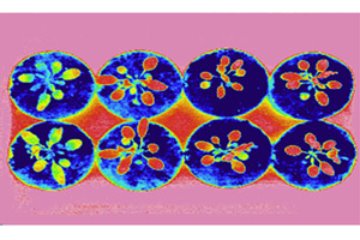Mar. 19, 2010 Research Highlight Biology
The ABC of a stress response
The identification of a gene involved in the response of plants to water stress should help breed better crop varieties
 Figure 1: Thermal images of two control plants (left) and six 4-week-old AtABCG25-overexpressing plants (right), captured by an infrared thermography device. © 2010 Takashi Kuromori
Figure 1: Thermal images of two control plants (left) and six 4-week-old AtABCG25-overexpressing plants (right), captured by an infrared thermography device. © 2010 Takashi Kuromori
When plants become desiccated, tiny leaf pores collectively called stomata close to conserve water. Each stoma is flanked by a pair of ‘guard cells’, which change shape to open or close the central pore.
This stress response involves the plant hormone abscisic acid (ABA). When produced in vascular tissues, ABA can act locally within cells via several known ABA receptors. However, to act on distant targets such as guard cells, this hormone must first be released from ABA-producing cells, raising the question of how it crosses the outer cell membrane.
To address this, Takashi Kuromori and colleagues of RIKEN Plant Science Center, Yokohama, screened over 12,000 lines of Arabidopsis—a commonly used plant model—for ABA-related mutants. Their identification of a mutant hypersensitive to ABA at the germination and seedling stages has led to the isolation of a gene encoding a type of ‘ATP-binding cassette (ABC) transporter’ 1.
ABC transporters use chemical energy stored in the biological molecule ATP to transport molecules across cell membranes and are present in organisms from bacteria to animals, including humans, but are especially prevalent in plants..
“Arabidopsis has 130 ABC transporter genes, while rice and beans each have more than 100, which means plants have 2–3 times more than other species,” says Kuromori.“We believe that some kinds of ABC transporters evolved to have important plant-specific functions in plant development and physiological regulation.”
The newly identified transporter, AtABCG25, is expressed mainly in vascular tissues, such as roots and leaf veins. Importantly, this transporter localizes to the outer cell membrane. Some types of ABC transporter localize to membranes surrounding structures within cells which means that they could not transport ABA out of ABA-producing cells to be released into the spaces between cells.
Plants genetically engineered to over express AtABCG25 had higher leaf temperature compared to normal plants (Fig. 1), and decreased water loss from isolated leaves. The researchers believe that ABA built up in the guard cells of the engineered plants, causing enhanced stomatal closure.
Although it remains unclear how ABA reached the guard cells from vascular tissues, they hope that their findings will lead to the breeding of stress-tolerant crops.
“To date, research on plant stress tolerance has focused on ABA synthesis and/or the expression of ABA target genes,” says Kuromori. “However, our results suggest the possibility of establishing methods to control ABA transport and migration, which could lead to new techniques for breeding stress-tolerant plants.”
References
- 1. Kuromori, T., Miyaji, T., Yabuuchi, H., Shimizu, H., Sugimoto, E., Kamiya, A., Moriyama, Y. & Shinozaki, K. ABC transporter AtABCG25 is involved in abscisic acid transport and responses. Proceedings of the National Academy of Sciences USA 107, 2361–2366 (2010). doi: 10.1073/pnas.0912516107
